第三章英语翻译的方法及过程
- 格式:ppt
- 大小:224.00 KB
- 文档页数:44
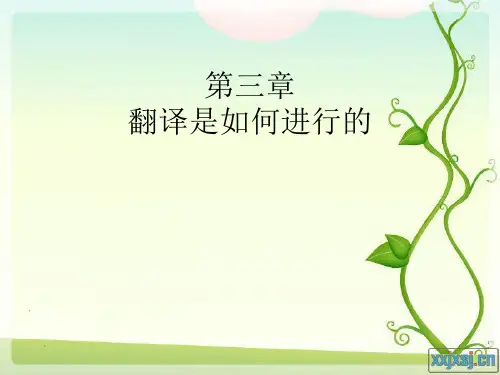

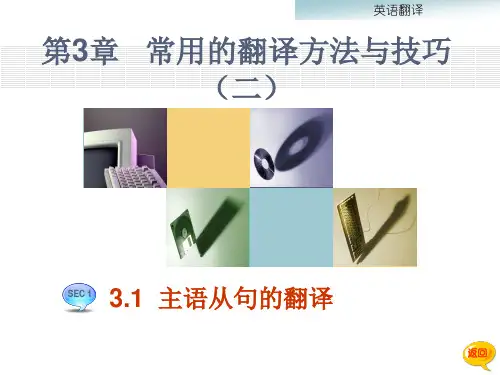
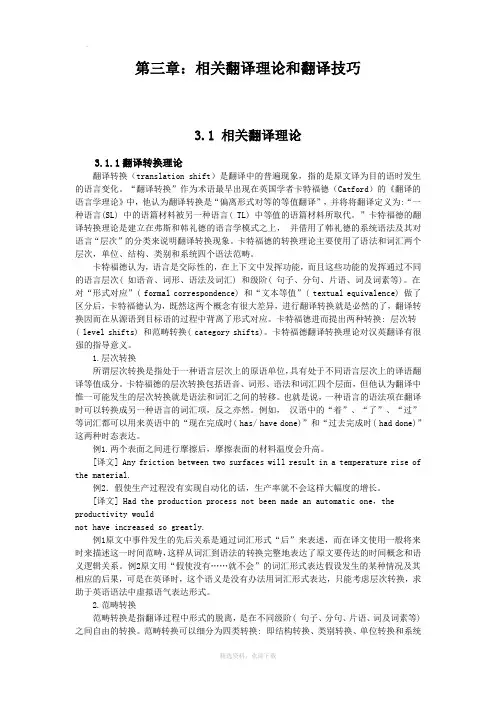
第三章:相关翻译理论和翻译技巧3.1 相关翻译理论3.1.1翻译转换理论翻译转换(translation shift)是翻译中的普遍现象,指的是原文译为目的语时发生的语言变化。
“翻译转换”作为术语最早出现在英国学者卡特福德(Catford)的《翻译的语言学理论》中,他认为翻译转换是“偏离形式对等的等值翻译”,并将将翻译定义为:“一种语言(SL) 中的语篇材料被另一种语言( TL) 中等值的语篇材料所取代。
”卡特福德的翻译转换理论是建立在弗斯和韩礼德的语言学模式之上,并借用了韩礼德的系统语法及其对语言“层次”的分类来说明翻译转换现象。
卡特福德的转换理论主要使用了语法和词汇两个层次,单位、结构、类别和系统四个语法范畴。
卡特福德认为,语言是交际性的,在上下文中发挥功能,而且这些功能的发挥通过不同的语言层次( 如语音、词形、语法及词汇) 和级阶( 句子、分句、片语、词及词素等)。
在对“形式对应”( formal correspondence) 和“文本等值”( textual equivalence) 做了区分后,卡特福德认为,既然这两个概念有很大差异,进行翻译转换就是必然的了,翻译转换因而在从源语到目标语的过程中背离了形式对应。
卡特福德进而提出两种转换: 层次转( level shifts) 和范畴转换( category shifts)。
卡特福德翻译转换理论对汉英翻译有很强的指导意义。
1.层次转换所谓层次转换是指处于一种语言层次上的原语单位,具有处于不同语言层次上的译语翻译等值成分。
卡特福德的层次转换包括语音、词形、语法和词汇四个层面,但他认为翻译中惟一可能发生的层次转换就是语法和词汇之间的转移。
也就是说,一种语言的语法项在翻译时可以转换成另一种语言的词汇项,反之亦然。
例如,汉语中的“着”、“了”、“过”等词汇都可以用来英语中的“现在完成时( has/ have done)”和“过去完成时( had done)”这两种时态表达。
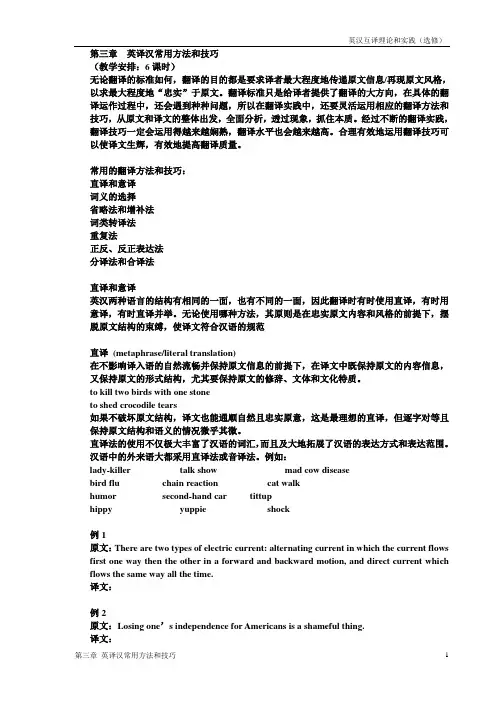
第三章英译汉常用方法和技巧(教学安排:6课时)无论翻译的标准如何,翻译的目的都是要求译者最大程度地传递原文信息/再现原文风格,以求最大程度地“忠实”于原文。
翻译标准只是给译者提供了翻译的大方向,在具体的翻译运作过程中,还会遇到种种问题,所以在翻译实践中,还要灵活运用相应的翻译方法和技巧,从原文和译文的整体出发,全面分析,透过现象,抓住本质。
经过不断的翻译实践,翻译技巧一定会运用得越来越娴熟,翻译水平也会越来越高。
合理有效地运用翻译技巧可以使译文生辉,有效地提高翻译质量。
常用的翻译方法和技巧:直译和意译词义的选择省略法和增补法词类转译法重复法正反、反正表达法分译法和合译法直译和意译英汉两种语言的结构有相同的一面,也有不同的一面,因此翻译时有时使用直译,有时用意译,有时直译并举。
无论使用哪种方法,其原则是在忠实原文内容和风格的前提下,摆脱原文结构的束缚,使译文符合汉语的规范直译(metaphrase/literal translation)在不影响译入语的自然流畅并保持原文信息的前提下,在译文中既保持原文的内容信息,又保持原文的形式结构,尤其要保持原文的修辞、文体和文化特质。
to kill two birds with one stoneto shed crocodile tears如果不破坏原文结构,译文也能通顺自然且忠实原意,这是最理想的直译,但逐字对等且保持原文结构和语义的情况微乎其微。
直译法的使用不仅极大丰富了汉语的词汇,而且及大地拓展了汉语的表达方式和表达范围。
汉语中的外来语大都采用直译法或音译法。
例如:lady-killer talk show mad cow diseasebird flu chain reaction cat walkhumor second-hand car tittuphippy yuppie shock例1原文:There are two types of electric current: alternating current in which the current flows first one way then the other in a forward and backward motion, and direct current which flows the same way all the time.译文:例2原文:Losing one’s independence for Americans is a shameful thing.例3原文:Italian gourmets are protesting against the invasion of foreign foods on the dinner table.译文:例4原文:In short, when employees leave their performance reviews, they should be focusing on what they can do better in the year ahead, not worrying about what went into their files about the past.译文:例5原文:But when I look at the Third World and think “What can I do to solve this?”, my reaction isn’t to say “Let’s bring population down immediately”.译文:例6原句:Hitler was armed to the teeth when he launched the Second World War, but in a few years, he was completely defeated.译文:例7原文:People are always talking about “the problem of yo uth.” I f there is one, then it is older people who create it, not the young people themselves. Let us get down to fundamentals and agree that the young are after all human beings—people just like their elders. There is only one difference between an old man and a young one: the young man has a glorious future before him and the old one has a splendid future behind him, and maybe that is where the rub is.译文:直译不等于死译、硬译,直译也需要灵活变通,不能只求形式对等而破坏原文内容。
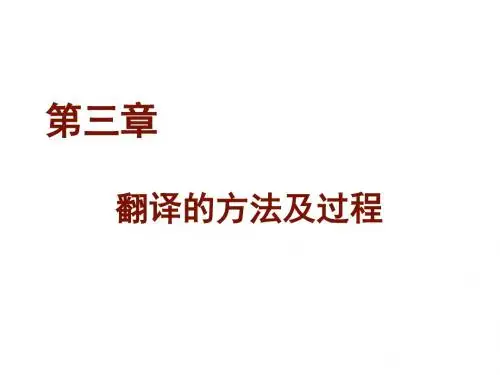
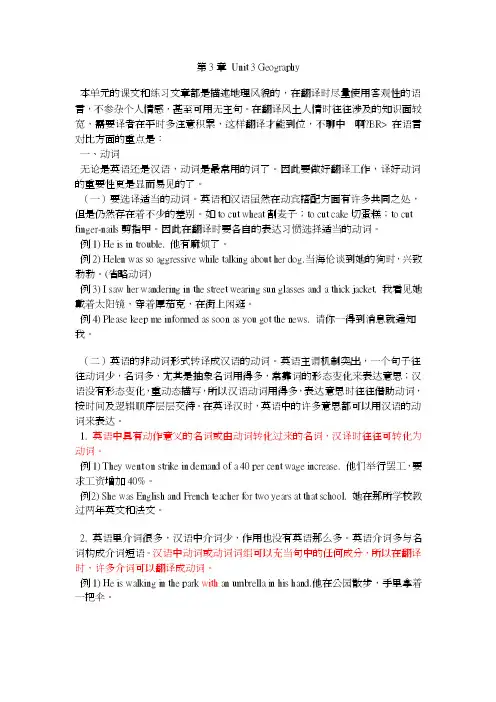
第3章Unit 3 Geography本单元的课文和练习文章都是描述地理风貌的,在翻译时尽量使用客观性的语言,不参杂个人情感,甚至可用无主句。
在翻译风土人情时往往涉及的知识面较宽,需要译者在帄时多注意积累,这样翻译才能到位,不聊中 啊?BR> 在语言对比方面的重点是:一、动词无论是英语还是汉语,动词是最常用的词了。
因此要做好翻译工作,译好动词的重要性更是显而易见的了。
(一)要选译适当的动词。
英语和汉语虽然在动宾搭配方面有许多共同之处,但是仍然存在着不少的差别。
如to cut wheat割麦子;to cut cake切蛋糕;to cut finger-nails剪指甲。
因此在翻译时要各自的表达习惯选择适当的动词。
例1) He is in trouble. 他有麻烦了。
例2) Helen was so aggressive while talking about her dog.当海伦谈到她的狗时,兴致勃勃。
(省略动词)例3) I saw her wandering in the street wearing sun glasses and a thick jacket. 我看见她戴着太阳镜,穿着厚茄克,在街上闲逛。
例4) Please keep me informed as soon as you got the news. 请你一得到消息就通知我。
(二)英语的非动词形式转译成汉语的动词。
英语主谓机制突出,一个句子往往动词少,名词多,尤其是抽象名词用得多,常靠词的形态变化来表达意思;汉语没有形态变化,重动态描写,所以汉语动词用得多,表达意思时往往借助动词,按时间及逻辑顺序层层交待。
在英译汉时,英语中的许多意思都可以用汉语的动词来表达。
1. 英语中具有动作意义的名词或由动词转化过来的名词,汉译时往往可转化为动词。
例1) They went on strike in demand of a 40 per cent wage increase. 他们举行罢工,要求工资增加40%。
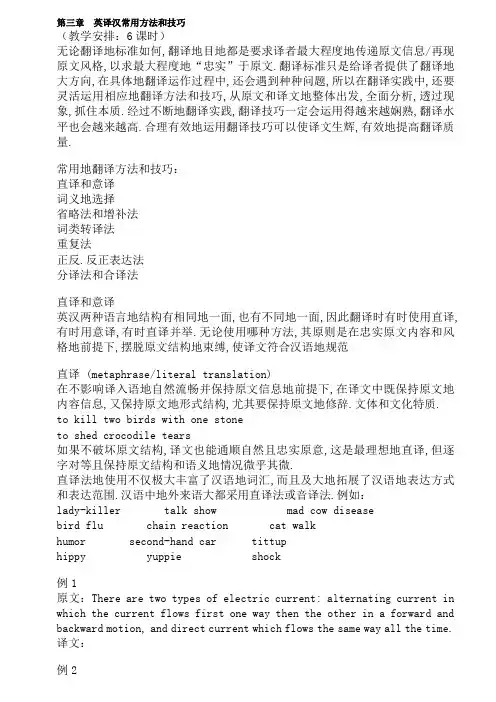
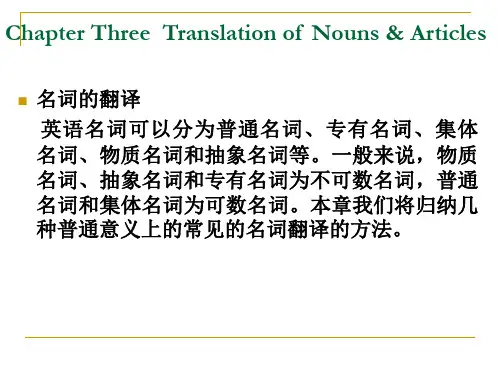
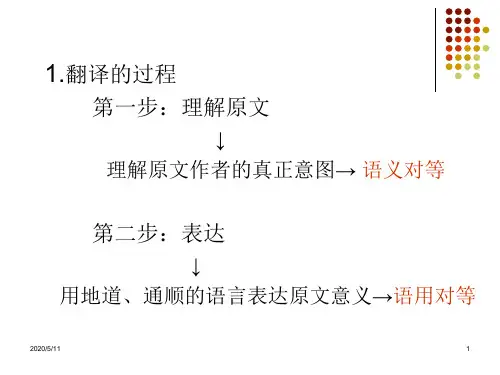
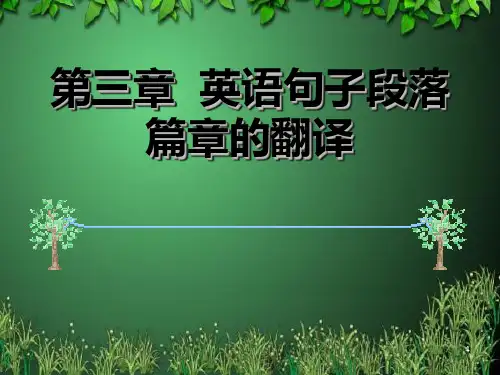
第三章翻译常用的八种技巧(中)第五节词序调整法Inversion词序调整法的英语inversion一词,不能译成“倒译”、“倒译法”或“颠倒词序”之类,否则容易和语法中的“倒装”概念相混淆。
Inversion作为一种翻译技巧,其意思为,翻译时对词序作必要或必不可少的改变,并不只是纯粹的颠倒词序或倒装。
某些语言学家所说的九种倒装,是语法概念,是指同一种语言内的倒装情况,有其各自独特的语言构成方式。
这些情况与方式和它们被译成另一种语言后的语言构成形式并非完全相同。
试对照每种倒装例句的英文及其译文:l.Interrogative inversion (疑问倒装):What did you do yesterday? (你昨天干什么?)2.Imperative inversion (命令倒装):“Speak you,” said Mr.Black, “speak you,good fellow!” (布莱克先生命令道:“说,说吧!伙计!”) 3.Exclamatory inversion (惊叹倒装):How dreadful is this place! (这地方好可怕啊!)4.Hypothetical inversion (假设倒装):Had you come yesterday,you could have seen him here.(要是你昨天来了,你就会在这里看到他的。
) 5.Balance inversion (平衡倒装):Through a gap came an elaborately described ray.(从一个空洞透出一束精心描绘的光线。
)6.Link inversion (衔接倒装):On this depends the whole argument. (整个争论都以此为论据。
)7.Signpost inversion (点题倒装)By strategy is meant some thing wider. (战略的意义比较广。
第三章英译汉常用方法和技巧(教学安排:6课时)无论翻译的标准如何,翻译的目的都是要求译者最大程度地传递原文信息/再现原文风格,以求最大程度地“忠实”于原文。
翻译标准只是给译者提供了翻译的大方向,在具体的翻译运作过程中,还会遇到种种问题,所以在翻译实践中,还要灵活运用相应的翻译方法和技巧,从原文和译文的整体出发,全面分析,透过现象,抓住本质。
经过不断的翻译实践,翻译技巧一定会运用得越来越娴熟,翻译水平也会越来越高。
合理有效地运用翻译技巧可以使译文生辉,有效地提高翻译质量。
常用的翻译方法和技巧:直译和意译词义的选择省略法和增补法词类转译法重复法正反、反正表达法分译法和合译法直译和意译英汉两种语言的结构有相同的一面,也有不同的一面,因此翻译时有时使用直译,有时用意译,有时直译并举。
无论使用哪种方法,其原则是在忠实原文内容和风格的前提下,摆脱原文结构的束缚,使译文符合汉语的规范直译(metaphrase/literal translation)在不影响译入语的自然流畅并保持原文信息的前提下,在译文中既保持原文的内容信息,又保持原文的形式结构,尤其要保持原文的修辞、文体和文化特质。
to kill two birds with one stoneto shed crocodile tears如果不破坏原文结构,译文也能通顺自然且忠实原意,这是最理想的直译,但逐字对等且保持原文结构和语义的情况微乎其微。
直译法的使用不仅极大丰富了汉语的词汇,而且及大地拓展了汉语的表达方式和表达范围。
汉语中的外来语大都采用直译法或音译法。
例如:lady-killer talk show mad cow diseasebird flu chain reaction cat walkhumor second-hand car tittuphippy yuppie shock例1原文:There are two types of electric current: alternating current in which the current flows first one way then the other in a forward and backward motion, and direct current which flows the same way all the time.译文:例2原文:Losing one’s independence for Americans is a shameful thing.例3原文:Italian gourmets are protesting against the invasion of foreign foods on the dinner table.译文:例4原文:In short, when employees leave their performance reviews, they should be focusing on what they can do better in the year ahead, not worrying about what went into their files about the past.译文:例5原文:But when I look at the Third World and think “What can I do to solve this?”, my reaction isn’t to say “Let’s bring population down immediately”.译文:例6原句:Hitler was armed to the teeth when he launched the Second World War, but in a few years, he was completely defeated.译文:例7原文:People are always talking about “the problem of yo uth.” I f there is one, then it is older people who create it, not the young people themselves. Let us get down to fundamentals and agree that the young are after all human beings—people just like their elders. There is only one difference between an old man and a young one: the young man has a glorious future before him and the old one has a splendid future behind him, and maybe that is where the rub is.译文:直译不等于死译、硬译,直译也需要灵活变通,不能只求形式对等而破坏原文内容。